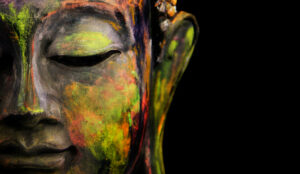
Join us at The Cove this Summer!
Join us for a week of teaching, time with God, fellowship, nature, and more at The Cove: A Billy Graham Training Center. July 21-25, 2025!
Read MoreBuddhism used to be considered only an “Asian religion,” but now it’s worldwide. Hollywood has taken to Buddhism, so you’ve been influenced by Buddhism in the messages of our culture, probably without even noticing. It has become a popular belief at colleges and universities and even among people from Christian families.
About 500 years before Jesus, a Hindu prince named Siddhartha Gautama lived a very sheltered life. He had everything he wanted growing up: the best food,

the finest clothes, the most beautiful women, plenty of servants, his own elephants! and all the money and power he desired. His father, the king of a small domain, had ‘always protected’ him from unpleasantness sometimes even paying citizens to smile so the prince wouldn’t be upset.
But when he was 29, this prince ventured away from the palace grounds and saw an old man, sick and bent over in pain. He also saw people who were hungry people who weren’t smiling, and even a dead body. Vowing to discover the meaning of life and suffering, the prince left his wife and his infant son at the palace. He gave up wealth and comfort and, instead, embraced hardship and pain. For six years, he denied himself basic needs and became so weak that he nearly drowned in a river. So he started eating normally again.
Then, when he was 35 years old, he sat under a tree and began to meditate. He decided that he wouldn’t move until he found the answers he was seeking. One night, he had a breakthrough. His mind cleared, he felt enlightened, and he finally believed he understood: life is suffering, and our purpose is to escape it. Under the tree, the Hindu prince became the enlightened one, the “awakened” one, the Buddha.
Siddhartha had lived a life of luxury and found it meaningless; then he lived a life of poverty and found it meaningless too. So he traveled a new path- the “Middle Way”- and realized that it was the best way to avoid suffering. In the “Middle Way,” there were no strong desires, no desperate needs-just existing.
The Buddha wandered around teaching and attracting a lot of followers for about 45 years before he died of food poisoning. He didn’t write any of his teachings down, they were collected by his followers. Eventually, about two centuries later, a Buddhist king sent missionaries to all parts of Asia, and the religion began to spread. It developed into a few different versions, and today, more than 6 percent of the world is Buddhist.

A couple hundred years after the Buddha’s death, two main branches of Buddhism developed-Mahayana Buddhism and Theravada Buddhism. They agree on the core teachings of Buddhism, but Theravada tends to be more conservative and often more focused on the individual. Theravada Buddhists emphasize each person working out his or her own salvation, on the personal process of getting to Nirvana.
Mahayana Buddhism is more broadly defined than Theravada Buddhism. It’s more inclusive of different traditions, and while Theravada is self-focused, Mahayana can sometimes have more of an emphasis on humanity as a whole. It tends to be a collectivist way of thinking-emphasizing releasing all living things from the cycle of suffering and also emphasizing the oneness of all humanity. Mahayana Buddhism accepts many sacred texts and teachers after the time of Buddha, while Theravada Buddhism has a closed canon and emphasizes that there was only one unique Buddha.

Buddha lived about the time of Daniel after Jerusalem had been destroyed and Judah was captive in Babylon. Many Buddhists will point out that their religion is older than Christianity, but it’s much younger than the stories of the Bible. Most of The Old Testament had already been written when Buddha lived. God was actively dealing with His people and preparing the way for the Messiah.
Read Matthew 25:31-40 and John 16:33. The beliefs the Buddha developed were all about escaping life, not fixing it. What do you think Jesus would have told Buddha about life?
The Buddha looked at the same world we do-not that we share his culture-and saw the same suffering we see. Think about the way the Buddha viewed life. Then think about how you see yours. Any similarities?
***
©2013, 2022 by Walk Thru the Bible Ministries, Inc taken from World Religions
Grab your copy of World Religions for 20% off August 1st, 2024 thru August 31, 2024!

Join us for a week of teaching, time with God, fellowship, nature, and more at The Cove: A Billy Graham Training Center. July 21-25, 2025!
Read More
As we observe Holy Week and celebrate our Risen Savior, I wanted to let you know that our Walk Thru the Bible President, Phil Tuttle, will be preaching the Good Friday Service (Friday, April 18) as well as the Easter Sunrise Service at the Garden Tomb in Jerusalem this Sunday.
Read More